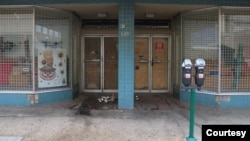For much of the world, the economic and social isolation brought by the peak days of the COVID-19 pandemic are fading. But at this inland port city on the U.S.-Mexico border, the hard times have dragged on.
U.S. authorities closed the border to non-essential travel in March 2020, drawing a hard line that cuts through the heart of this bi-national metro area known locally as “the two Laredos” — Laredo, Texas, and Nuevo Laredo, Mexico.
Nineteen months of closure split up families and drove a wedge through economies on both sides. When the border reopens on Monday, Nov. 8, the region will be eager to take a breath of fresh air and renew cross-border connections.
Many Laredo residents like 57-year-old Belen Zamora haven’t seen their loved ones across the border since it closed. Although she has lived in Laredo for years, she isn’t a U.S. resident, and if she had gone to Mexico during the closure, she wouldn’t have been able to return. Her four brothers and 10 cousins in Anahuac, Mexico, an hour’s drive away, used to visit her a few times each month, but they haven’t been able to come.
“For us, family is very important,” she said, choking back tears. “Even though there’s technology now, it will never replace a hug, a meal, or time with the family.”
She said her brothers will be waiting to cross on Monday when the bridge reopens for a long-awaited family reunion. But not everything in Laredo is expected to rebound as quickly as its families.
In old downtown, nestled along the Mexican border, more than half the buildings are either boarded up or closed. Dust gathers on old merchandise in shop windows. A few blocks away, the Rio Grande cuts through the center of an urban area with 260,000 people in Texas and 450,000 in Mexico. A pedestrian bridge over a mucky river connects the sister cities’ historic downtowns.
“This place used to always be full,” said Carol Galvez, manager of a big-box electronics store two blocks from the international bridge. She used to sell smart TVs and meter-tall speakers to crowds of shoppers who would come from all over Mexico to buy cheap goods and American brands in Texas.
Since the border closed, sales have fallen 50%, and more than half the downtown businesses that were open before the pandemic have closed, she said.
“When I walk around here it makes me sad. It’s all empty, all abandoned,” said Jose Arevalo, manager of a clothes printing shop. “Hopefully things get better when the Mexicans come back.”
Not all businesses in Laredo suffered. This city hosts the largest inland port of the Americas, which occasionally takes the top ranking for busiest U.S. port by value of merchandise
Commerce at the Port of Laredo weathered the pandemic and workers there were considered essential. It was the small businesses and the region’s characteristic informal economy that took the heaviest blows.
The ban on non-essential travel shrank pedestrian traffic on the downtown bridge from 3,460,000 crossings in the first six months of 2019 to 1,482,000 crossings in the first six months of this year, according to data compiled by the Texas Center at Texas A&M International University. Non-commercial vehicle crossings over nearby bridges fell from 5,280,000 to 3,145,000 over the same period.
Not all those people came to Laredo to shop. Many commuted across the bridge each day or week using U.S. border crossing cards to work regular but informal jobs on the Texas side of the border, contributing to the region’s economic lifeblood for generations.
“The government is fully aware [how border crossing cards are used],” said Israel Reyna, an attorney at Texas RioGrande Legal Aid, a nonprofit that provides free representation to low-income clients. “There’s an unwritten policy of looking the other way.”
Thousands of people came from the Mexican side to work at construction sites, restaurant kitchens, retail shops, auto mechanics and private homes. They came to sell snacks on the street or offer yard work in neighborhoods.
“I don’t think there’s anyone who could point you to figures on that; it’s a no-no,” said Roman Ramos, a paralegal at Texas RioGrande Legal Aid since 1980.
Ramos said he used to see several dozen women get off at his neighborhood bus stop to go to work cleaning local homes, like others did across much of Laredo. When the border closed, those women disappeared.
“You would see busloads of women,” said Ariadne Gonzalez, an assistant professor at Texas A&M International University who wrote her doctoral thesis about the border crossing houseworkers in Laredo. “Their livelihoods have been completely halted.”
Two of the women she used to follow have told her they went looking for work in other parts of Mexico. Others found lower paying jobs in Nuevo Laredo. Gonzalez has lost contact with most of them.
“I don’t know if a lot of these domestic workers will come back,” she said. “I don’t know if a lot of these businesses will come back.”
The Laredo Chamber of Commerce has a plan to boost recovery, according to the organization’s president, Gabriela Morales.
The business group is preparing a reopening campaign aimed at bringing back Mexican shoppers. “Regresa a Laredo” or “Return to Laredo,” focuses on four key sectors — retail, restaurants, entertainment and hotels. The chamber is recruiting local businesses to offer coupons and discounts written in Spanish to be published online and handed out in person on the pedestrian bridge.
“This is something the business community was desperately waiting for, just waiting 19 months for the reopening of the border,” said Morales, who also hasn’t seen her family in Torreon, Mexico since the border closed. “It’s been very hard on people, the economy, the community and society in general.”









